Norina Bogatec, Zaira Vidau (editors)
Carocci editore, SLORI, Rim, 2016
This substantial publication contains useful material through which the readers can gain an in-depth understanding of the Slovene ethnic minority in Italy and its associational, cultural and socio-political activities in the light of events that unfolded in this border area between Italy and Slovenia during the last 25 years. The interdisciplinary approach allows for a thorough and articulate analysis based on a rigorous scientific methodology and a large number of bibliographical sources. The editorial team was led by two researchers from the Slovene Research Institute (SLORI), Norina Bogatec and Zaira Vidau. Other editorial board members are experts in the field of historic ethnic and linguistic communities, as well as professionals in publishing and advertising. Many articles were written by researchers, academics and experts in their respective fields. A number of articles were written by representatives of ethnic communities that maintain close intercultural and cross-border relations with the Slovene ethnic community in Italy, namely representatives of the Italian majority population and the Friulian community in the Friuli Venezia Giulia region, as well as representatives of the Italian ethnic community in Slovenia and Croatia.
The monograph is divided in three sections. The first section comprises six introductory articles that describe the major historical, legal, demographic and socio-political features of the Slovene ethnic community in Italy. The second section provides an analysis of the state of affairs and of the changes that have taken place since the beginning of the 1990s and have had a significant impact on Slovene community in Italy. It consists of ten articles, one for each of the following areas: language, national identity, education, culture, sports, religion, the media, political participation, the welfare state and the economy. The third section is a collection of the opinions and viewpoints of four “external observers”.
This comprehensive research describes a community that, in its own small way, must face the advantages and disadvantages inherent to modern times. Due to the “congenital” vulnerability characteristic of minorities, the socio-political changes that have been happening since the fall of the Berlin wall, on a local and a European level alike, have had a much stronger impact on minorities than they would have in other cases. Furthermore, increased migration, globalisation and the enhanced mobility of young people have also had an impact on the cultural scene, both in the immediate and wider social environment. Improved relations between the Slovene and Italian population living in the Friuli Venezia Giulia region and the positive outcomes of cross-border cooperation between Italy and Slovenia have led to the creation of new intercultural situations and identities where various languages and cultures intertwine, interact and even merge. The most challenging question that members of the Slovene ethnic community in Italy will need to answer in the 21st century is undoubtedly how to preserve and strengthen the longstanding presence of the Slovene population in the Friuli Venezia Giulia region in an increasingly complex and rapidly changing contemporary society.
